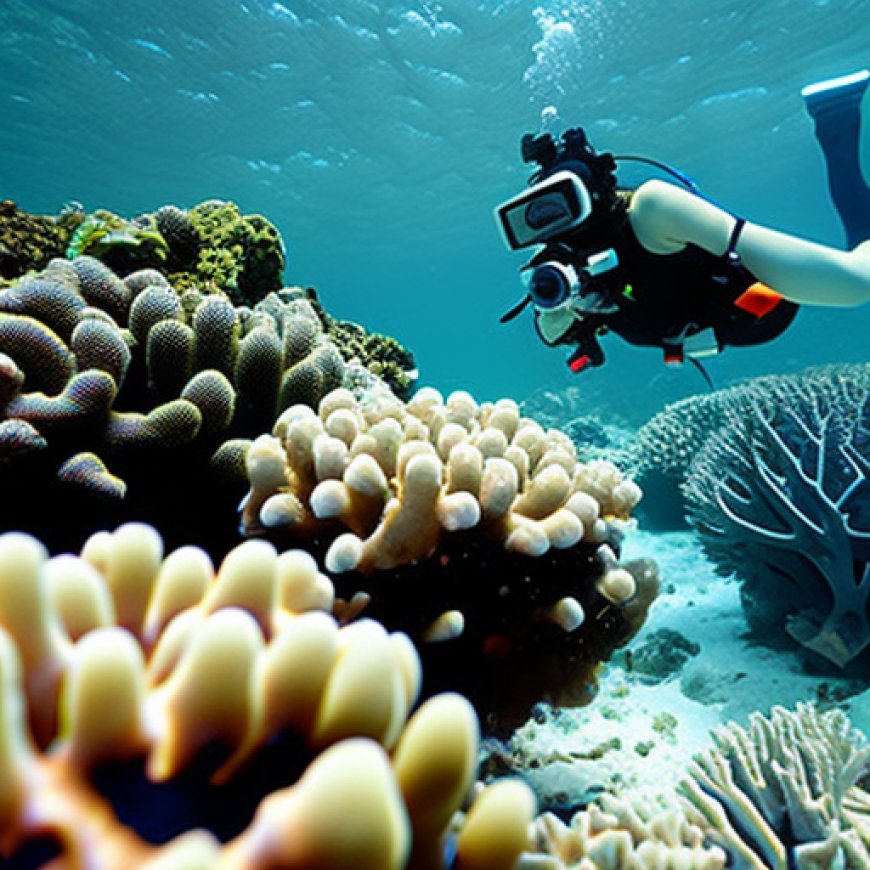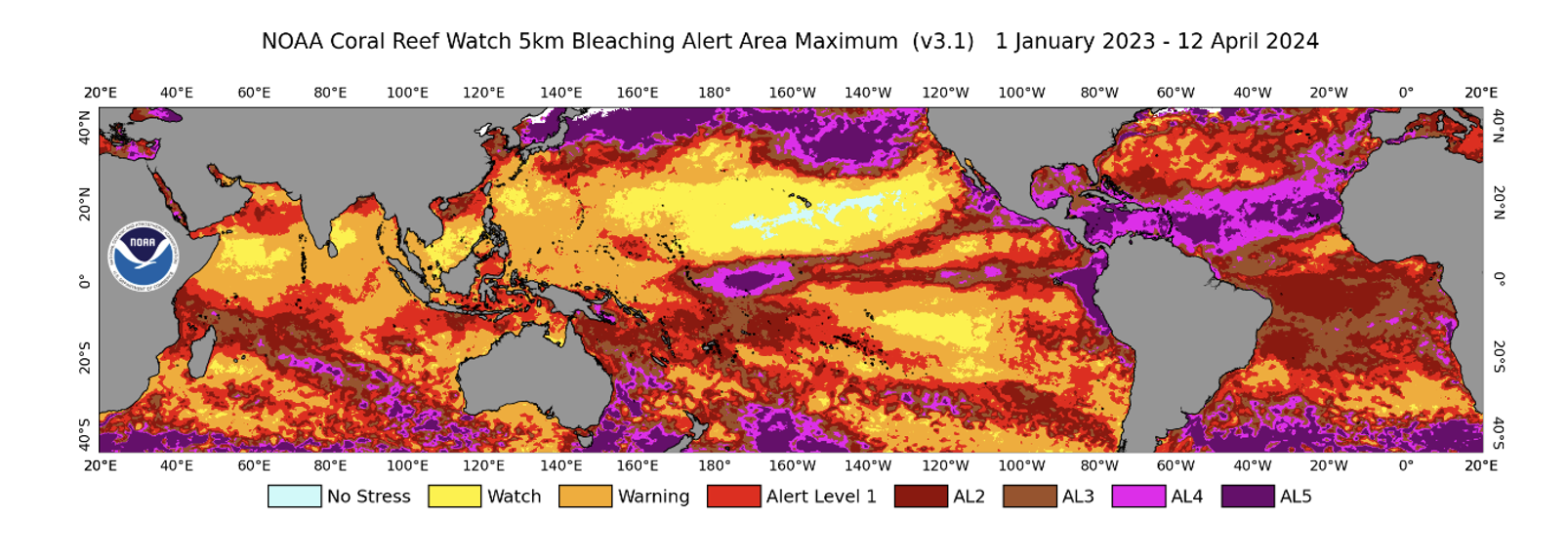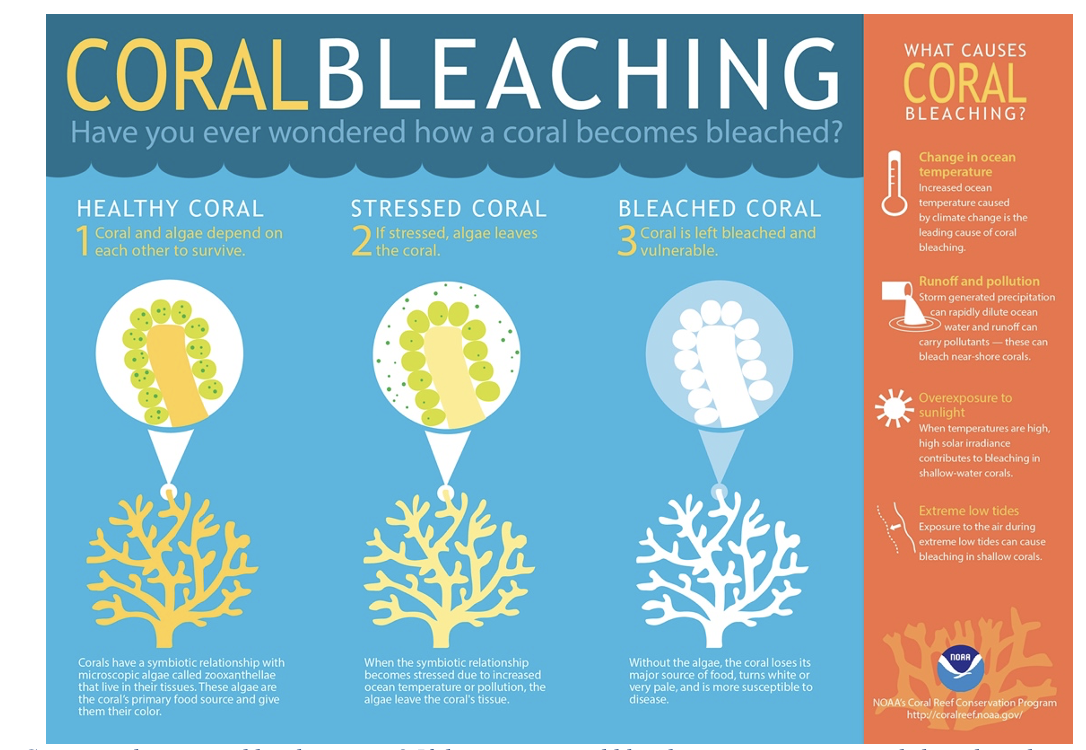Guest Article: Fourth Global Bleaching Event Threatens Corals Worldwide | SDG Knowledge Hub | IISD
Guest Article: Fourth Global Bleaching Event Threatens Corals Worldwide | SDG Knowledge Hub | IISD IISD's SDG Knowledge Hub


Healthy Coral Reefs: A Report on the Fourth Global Coral Bleaching Event
By Francis Staub and Thomas Dallison, ICRI Secretariat
Healthy, thriving, and resilient coral reefs are essential for a healthy planet. One billion people depend on coral reefs for coastal protection, recreation and tourism, sources of animal protein, and fisheries. Coral reefs support livelihoods and generate values of up to USD 9.9 trillion each year. Coral reefs also hold strong cultural and traditional values with a significant proportion of dependency from Indigenous Peoples, local communities, and island nations. Yet, despite this immense value to people and nature, coral reefs continue to face mounting threats.
It is estimated that approximately 50% of coral reefs have been lost since the 1950s. The Global Coral Reef Monitoring Network (GCRMN), an operational network of the International Coral Reef Initiative (ICRI), highlighted a 14% loss of the world’s coral reefs in 2009-2018, driven by climate change and anthropogenic stressors.
On 15 April 2024, the US National Oceanic and Atmospheric Agency (NOAA) and ICRI emphasized the continuing decline of these critical ecosystems through the announcement of the world’s Fourth Global Coral Bleaching Event. This event, the second in ten years, was confirmed by NOAA and ICRI’s network of global coral reef scientists.
Current Status of Coral Bleaching
Mass bleaching of coral reefs since early 2023 (Figure 1) has been confirmed in over 50 countries, territories, and local economies, including:
- Florida (US)
- The Caribbean
- The Eastern Tropical Pacific (including Mexico, El Salvador, Costa Rica, Panama, and Colombia)
- Australia’s Great Barrier Reef
- Large areas of the South Pacific (including Fiji, Vanuatu, Tuvalu, Kiribati, and the Samoas)
- The Red Sea (including the Gulf of Aqaba)
- The Persian Gulf
- The Gulf of Aden
- Parts of the Western Indian Ocean (including Tanzania, Kenya, Mauritius, Seychelles, Tromelin, Mayotte, and off the western coast of Indonesia)

Figure 1. A map presenting the maximum Bleaching Alert Levels reached since the beginning of 2023. Credit: NOAA Coral Reef Watch
Impacts of Coral Bleaching
This finding must be viewed as an urgent call for immediate action for coral reefs and a clear warning for the state of the global Ocean, its biodiversity, and the entirety of the human population who depend on it. Where coral bleaching results in mortality (Figure 2), especially on a widespread scale, it impacts economies, livelihoods, food security, and more. Coral reefs harbor upwards of 25% of all marine biodiversity. Thus, their decline threatens the existence and survival of at least one in every four living organisms in the Ocean.

Figure 2. Can a coral survive a bleaching event? If the stress-caused bleaching is not severe, corals have been known to recover. If the algae loss is prolonged, and the stress continues, the coral eventually dies. Credit: NOAA
However, it is important to remember that coral bleaching does not always lead to coral death. Rather, if the stress driving the bleaching diminishes, corals can recover, and reefs can continue to provide ecosystem services through maintaining biodiversity and nature’s health. Where corals can recover, bleached corals often exhibit reductions in growth and impaired reproduction output for up to five years following the bleaching event and are highly susceptible to disease for up to two years post-bleaching.
Actions for Coral Reefs
While coral reefs can recover from bleaching events, the increased frequency of such events, driven by climate change, reduces the window of recovery for corals, thus leading to a continued decline in reef health. Therefore, the impacts of bleaching can significantly impair the resilience and recovery potential of coral reefs. This drives the need for a rich suite of solutions that promote the conservation, protection, and resilience of coral reefs.
The Fourth Global Coral Bleaching Event requires global action. ICRI, a partnership of 101 international members, currently co-chaired by NOAA and the US Department of State, is steadfast in applying resilience-based management actions for coral reefs. In response to the three previous global bleaching events as well as regional and local events, ICRI and its members have advanced coral interventions and restoration in the face of climate change. ICRI develops and shares best practices for the effective management of coral reefs through the implementation of its Plan of Action.
ICRI also urges all its partners and other stakeholders to support the Coral Reef Breakthrough aiming to secure the future of at least 125,000 square kilometers of shallow-water tropical coral reefs with investments of at least USD 12 billion to support the resilience of more than half a billion people globally by 2030. These targets are critical for driving momentum for action and are in line with the targets of the Kunming-Montreal Global Biodiversity Framework (GBF), and many national 2030 strategies. The targets are supported by four specific action points:
- Stop drivers of loss;
- Double the area of coral reefs under effective protection and bolster resilience-based efforts;
- Accelerate restoration to impact 30% of degraded reefs by 2030; and
- Secure investments from public and private sources of at least USD 12 billion.
Monitoring and Collaboration
Global bleaching events do not affect all coral reefs equally and require global, regional, and local interventions. This emphasizes the importance of regularly monitoring coral reef ecosystems, and not just during bleaching events. Networks such as the Global Coral Reef Monitoring Network and national programmes such as the US Coral Reef Task Force provide mechanisms for reporting on the impact of bleaching on the world
SDGs, Targets, and Indicators in the Article
1. Which SDGs are addressed or connected to the issues highlighted in the article?
- SDG 14: Life Below Water
- SDG 15: Life on Land
The article discusses the decline of coral reefs and the impact of coral bleaching events on marine biodiversity and ecosystems. These issues are directly related to SDG 14, which focuses on conserving and sustainably using the oceans, seas, and marine resources. Additionally, the article mentions that coral reefs support livelihoods and generate economic value, highlighting the connection to SDG 15, which aims to protect, restore, and promote sustainable use of terrestrial ecosystems.
2. What specific targets under those SDGs can be identified based on the article’s content?
- SDG 14.2: By 2020, sustainably manage and protect marine and coastal ecosystems to avoid significant adverse impacts, including by strengthening their resilience, and take action for their restoration in order to achieve healthy and productive oceans.
- SDG 14.5: By 2020, conserve at least 10 percent of coastal and marine areas, consistent with national and international law and based on the best available scientific information.
- SDG 14.7: By 2030, increase the economic benefits to Small Island Developing States (SIDS) and least developed countries from the sustainable use of marine resources, including through sustainable management of fisheries, aquaculture, and tourism.
- SDG 15.5: Take urgent and significant action to reduce the degradation of natural habitats, halt the loss of biodiversity, and protect and prevent the extinction of threatened species.
Based on the article’s content, the targets mentioned above are relevant to address the decline of coral reefs, protect marine ecosystems, conserve coastal and marine areas, and promote sustainable use of marine resources.
3. Are there any indicators mentioned or implied in the article that can be used to measure progress towards the identified targets?
- Percentage of coral reefs lost or degraded
- Extent of coral bleaching events
- Area of coral reefs under effective protection
- Economic benefits from the sustainable use of marine resources in SIDS and least developed countries
- Reduction in the degradation of natural habitats and loss of biodiversity
The article mentions the loss of coral reefs and the occurrence of coral bleaching events as indicators of the decline in marine ecosystems. It also highlights the need to increase the area of coral reefs under effective protection and the economic benefits from sustainable use. Additionally, reducing the degradation of natural habitats and preventing species extinction are indicators relevant to measuring progress towards the identified targets.
Table: SDGs, Targets, and Indicators
| SDGs | Targets | Indicators |
|---|---|---|
| SDG 14: Life Below Water | 14.2: By 2020, sustainably manage and protect marine and coastal ecosystems to avoid significant adverse impacts, including by strengthening their resilience, and take action for their restoration in order to achieve healthy and productive oceans. | – Percentage of coral reefs lost or degraded – Extent of coral bleaching events |
| SDG 14: Life Below Water | 14.5: By 2020, conserve at least 10 percent of coastal and marine areas, consistent with national and international law and based on the best available scientific information. | – Area of coral reefs under effective protection |
| SDG 14: Life Below Water | 14.7: By 2030, increase the economic benefits to Small Island Developing States (SIDS) and least developed countries from the sustainable use of marine resources, including through sustainable management of fisheries, aquaculture, and tourism. | – Economic benefits from the sustainable use of marine resources in SIDS and least developed countries |
| SDG 15: Life on Land | 15.5: Take urgent and significant action to reduce the degradation of natural habitats, halt the loss of biodiversity, and protect and prevent the extinction of threatened species. | – Reduction in the degradation of natural habitats and loss of biodiversity |
Behold! This splendid article springs forth from the wellspring of knowledge, shaped by a wondrous proprietary AI technology that delved into a vast ocean of data, illuminating the path towards the Sustainable Development Goals. Remember that all rights are reserved by SDG Investors LLC, empowering us to champion progress together.
Source: sdg.iisd.org

Join us, as fellow seekers of change, on a transformative journey at https://sdgtalks.ai/welcome, where you can become a member and actively contribute to shaping a brighter future.







